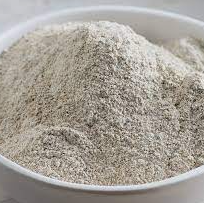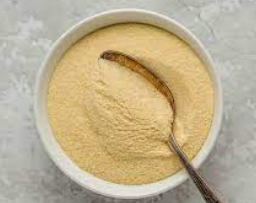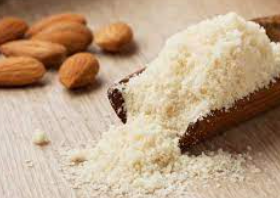Flour is a versatile ingredient that is used in a variety of cooking and baking applications.
Each type of flour has its own unique characteristics and is best suited for certain types of cooking and baking. When choosing flour for a recipe, it is important to consider the recipe’s requirements and the flour’s properties to ensure the best results.
- All-purpose flour.
- Bread flour.
- Cake flour.
- Pastry flour.
- Self-rising flour.
- Whole wheat flour.
- Gluten-free flour.
- Rye flour.
- Durum flour.
- Almond flour.
1. All-Purpose flour

All-purpose flour is a versatile ingredient that is widely used in various recipes such as bread, cakes, pastries, and more. It is made from a blend of hard and soft wheat and can be found in most grocery stores. While all-purpose flour can provide numerous benefits, it also has some potential side effects that people should be aware of.
1.1 Benefits
- Versatility: All-purpose flour can be used in a wide range of recipes, making it a versatile ingredient in the kitchen. From cakes to bread to pizza crust, it provides a neutral flavor and a light texture that works well with different flavors and ingredients.
- Nutritional value: All-purpose flour is a good source of carbohydrates, which are an essential source of energy for the body. It also contains small amounts of protein and fat, as well as minerals such as iron and zinc.
- Availability: All-purpose flour is widely available in grocery stores and is relatively inexpensive, making it an accessible ingredient for many households.
1.2 Side Effects
- Gluten sensitivity: All-purpose flour contains gluten, a protein found in wheat, that can cause problems for those with gluten sensitivity or celiac disease. Symptoms may include bloating, abdominal pain, and diarrhea.
- Blood sugar levels: All-purpose flour is a simple carbohydrate that can cause a spike in blood sugar levels, which may be problematic for people with diabetes or those who are trying to control their blood sugar.
- Weight gain: Consuming large amounts of all-purpose flour may contribute to weight gain, as it is a high-calorie and high-carbohydrate food that can be easy to overeat.
- Nutrient deficiencies: All-purpose flour is often enriched with nutrients such as iron and B vitamins, but it is still a refined food that may not provide the same level of nutrients as whole grains.
- Inflammatory effects: Some studies suggest that consuming large amounts of refined carbohydrates, such as all-purpose flour, may have inflammatory effects in the body, which can contribute to chronic diseases like heart disease and cancer.
2.3 Conclusion
Overall, all-purpose flour can provide numerous benefits in the kitchen, but it is important to consume it in moderation and be aware of any potential side effects. People with gluten sensitivity or celiac disease should opt for gluten-free flours, while those looking for more nutrients may want to consider whole grain flours as an alternative.
2. Bread flour
Bread flour, also known as high-gluten flour, is a type of flour that is specifically designed for baking bread. It has a higher protein content than all-purpose flour, which makes it ideal for bread-making because it creates a stronger gluten network, resulting in a better rise and texture.

2.1 Benefits
- Better texture: Bread flour’s high protein content creates a stronger gluten network that helps the dough hold its shape and rise better, resulting in a better texture.
- More flavorful: Bread flour is often milled from hard wheat, which has a higher protein content than soft wheat used in all-purpose flour. This higher protein content results in a richer, more complex flavor in the finished bread.
- Consistent results: Because bread flour has a consistent protein content, it creates consistent results in bread baking.
2.2 Side Effects
- Gluten Sensitivity: Bread flour’s high protein content can make it problematic for people with gluten sensitivity or celiac disease.
- Over-Kneading: Over-kneading bread dough made with bread flour can cause it to become tough and chewy.
- Calorie Count: Bread flour is a high-calorie food, so it should be consumed in moderation by people watching their calorie intake.
- Not ideal for some baked goods: Bread flour’s high protein content can result in a tough, chewy texture in some baked goods, such as cakes and pastries. For these recipes, it is better to use a lower protein flour, such as all-purpose flour.
2.3 Conclusion
In conclusion, bread flour has several benefits when it comes to bread-making, including better texture, flavor, and consistent results. However, it may not be suitable for individuals with gluten sensitivity, and over-kneading can lead to tough and chewy bread. Additionally, it may not be the best option for some baked goods, such as cakes and pastries.
3. Cake flour
Cake flour is a type of wheat flour that is used to make cakes, cookies, and other delicate baked goods. It has a lower protein content compared to all-purpose flour, making it finer and lighter. This type of flour is usually made from soft wheat, which has a lower gluten content, and is processed to create a smoother, more delicate texture.

3.1 Benefits
- Perfect for delicate baked goods: The fine texture of cake flour makes it perfect for delicate baked goods like cakes and cookies.
- Light and fluffy texture: Because cake flour has a lower protein content, it produces a lighter and fluffier texture in baked goods.
- Better rise: The lower protein content also means that cake flour allows for a better rise in baked goods, resulting in taller cakes and fluffier cookies.
- Absorbs moisture well: Cake flour has the ability to absorb moisture, which helps to keep baked goods moist and tender.
- Reduced gluten: Cake flour is low in gluten, which makes it suitable for people with gluten sensitivity or intolerance.
3.2 Side Effects
- May be too fine for some recipes: The fine texture of cake flour may not be suitable for some recipes, such as bread or pizza dough.
- May result in a crumbly texture: Due to its low protein content, cake flour may result in a crumbly texture if not used in the right proportion.
- May not provide enough structure: The low protein content of cake flour means it may not provide enough structure to certain baked goods, resulting in a flat or dense texture.
- May contain additives: Some cake flour brands may contain additives like bleach or bromate, which can have negative health effects.
3.3 Conclusion
Overall, cake flour is a great option for delicate baked goods like cakes and cookies, but may not be suitable for all recipes. It is important to use it in the right proportion and be aware of any additives that may be present in some brands.
4. Pastry flour
Pastry flour is a type of wheat flour that is commonly used in baking pastries, cookies, cakes, and other delicate baked goods. It is known for its low protein content, which results in tender and delicate baked goods. Here are some of the benefits and side effects of using pastry flour:

4.1 Benefits
- Tender baked goods: Pastry flour has a lower protein content compared to other flours. This means that it produces less gluten when mixed with liquid. Gluten is responsible for the elasticity and chewiness in baked goods. With less gluten, pastry flour produces tender and delicate baked goods.
- Better texture: Pastry flour gives a smoother and finer texture to baked goods, making them more desirable.
- Improved taste: Pastry flour has a finer grind than all-purpose flour, which results in a finer texture and improved taste in baked goods.
- More crumbly: Because of its lower protein content, pastry flour produces more crumbly baked goods. This is particularly desirable in pastry recipes, where a delicate and crumbly texture is preferred.
- Great for pie crusts: Pie crusts made with pastry flour are known to be tender and flaky, making them perfect for pie recipes.
4.2 Side Effects
- Not suitable for bread: The low protein content in pastry flour makes it unsuitable for making bread. Breads need a higher protein content to develop gluten, which is what gives bread its structure and chewiness.
- Limited use: Pastry flour is best suited for delicate baked goods, but it may not work well in other recipes that require a higher protein content.
- More expensive: Pastry flour can be more expensive than all-purpose flour or bread flour due to its limited use and finer grind.
- Shorter shelf life: Because of its lower protein content, pastry flour has a shorter shelf life compared to other types of flour. It is important to store it in an airtight container in a cool, dry place to prevent spoilage.
- Fewer nutrients: Pastry flour has less protein compared to other types of flour, which means it has fewer nutrients. It is important to balance the use of pastry flour with other types of flour to ensure a well-rounded diet.
4.3 Conclusion
In conclusion, pastry flour is an excellent choice for creating delicate and tender baked goods, such as cakes, biscuits, and pie crusts. However, it is not suitable for making bread, and it has a lower nutritional value compared to all-purpose flour. If you are looking to make delicate and tender baked goods, then pastry flour is an excellent choice. However, if you need a more versatile flour that can be used in a variety of recipes, then all-purpose flour may be a better choice.
5. Self-rising flour
Self-rising flour is a type of flour that is often used in baking. It is a combination of all-purpose flour, baking powder, and salt, which are mixed together to create a versatile flour that can be used in a variety of recipes. In this article, we will discuss the benefits and side effects of self-rising flour.

5.1 Benefits
- Convenience: One of the biggest benefits of using self-rising flour is its convenience. Since it already contains baking powder and salt, you don’t need to measure and add them separately. This can save you time and make baking easier.
- Consistency: Using self-rising flour ensures that you have a consistent leavening agent in your baking, which can help prevent flat or dense baked goods.
- Versatility: Self-rising flour can be used in a variety of recipes, including cakes, biscuits, pancakes, and more. It can also be used to thicken sauces and gravies.
- Long Shelf Life: Self-rising flour has a longer shelf life compared to other types of flour, as the baking powder and salt help to preserve it.
5.2 Side Effects
- Sodium Content: Self-rising flour contains salt, which can increase the sodium content of your baked goods. This can be a concern for people who need to limit their sodium intake due to health reasons.
- Limited Control: Using self-rising flour means that you have limited control over the leavening agent in your baking. This can be a disadvantage if you need to adjust the amount of baking powder or salt in your recipe.
- Taste: Some people find that the taste of self-rising flour is slightly different compared to other types of flour. However, this is subjective and can vary depending on personal preference.
- Price: Self-rising flour can be more expensive than other types of flour due to the added ingredients.
5.3 Conclusion
Self-rising flour is a convenient and versatile option for baking. Its benefits include convenience, consistency, versatility, and a longer shelf life. However, it is important to be aware of its sodium content, limited control, taste, and price. If you are concerned about these factors, it may be best to use other types of flour or to make your own self-rising flour by combining all-purpose flour, baking powder, and salt.
6. Whole wheat flour
Whole wheat flour is a type of flour that is made from whole grains of wheat, including the bran, germ, and endosperm. It has a coarse texture and a slightly nutty taste. Whole wheat flour is often considered to be healthier than other types of flour because it contains more nutrients and fiber. However, it also has some potential side effects.

6.1 Benefits
- Rich in Nutrients: Whole wheat flour is a good source of vitamins, minerals, and fiber. It contains more vitamins B and E, magnesium, phosphorus, zinc, and folic acid than all-purpose flour.
- Better for Digestion: The fiber content in whole wheat flour is higher than other types of flour. This makes it better for digestion and helps to prevent constipation.
- Lowers Cholesterol: Whole wheat flour contains soluble fiber, which helps to lower cholesterol levels in the blood. This can help to reduce the risk of heart disease.
- Maintains Blood Sugar Levels: Whole wheat flour has a lower glycemic index than other types of flour. This means that it does not cause a rapid increase in blood sugar levels. It is, therefore, a better option for people with diabetes.
- Helps with Weight Management: The fiber content in whole wheat flour helps to promote a feeling of fullness, which can help with weight management.
6.2 Side Effects
- Gluten Intolerance: Whole wheat flour contains gluten, which is a protein that some people are intolerant to. People with celiac disease or gluten sensitivity should avoid whole wheat flour.
- Digestive Issues: Some people may experience digestive issues such as bloating, gas, and diarrhea after consuming whole wheat flour. This is because the high fiber content can be difficult for some people to digest.
- Interference with Nutrient Absorption: Whole wheat flour contains phytic acid, which can interfere with the absorption of certain nutrients, such as calcium, iron, and zinc. This can be a concern for people who rely heavily on whole wheat flour as a dietary staple.
- May Cause Weight Gain: Although the fiber content in whole wheat flour can help with weight management, consuming too much of it can lead to weight gain. This is because it is high in calories.
6.3 Conclusion
In conclusion, whole wheat flour has several benefits for health, but it also has potential side effects that should be considered. It is best to consume whole wheat flour in moderation and to consult a healthcare professional if you have any concerns about your diet.
7. Gluten-free flour
Gluten-free flour is a type of flour that does not contain the protein gluten, which is commonly found in wheat, barley, and rye. It is often used as a substitute for traditional wheat flour in baking and cooking for individuals who have gluten intolerance, celiac disease, or wheat allergy.

7.1 Benefits
- Gluten-free flour is safe for people who have celiac disease or gluten intolerance. It can help them enjoy their favorite foods without experiencing adverse effects such as digestive problems, skin rashes, and fatigue.
- Gluten-free flour is made from a variety of grains and nuts, such as rice, corn, almonds, and quinoa. This provides a wider range of nutrients such as fiber, protein, vitamins, and minerals, compared to wheat flour.
- Gluten-free flour can be a good option for people who are trying to lose weight or improve their overall health, as it typically contains fewer calories and less fat than wheat flour.
- Some studies have shown that a gluten-free diet can help reduce inflammation in the body, which can have a positive impact on conditions such as arthritis, irritable bowel syndrome (IBS), and autoimmune disorders.
7.2 Side Effects
- Gluten-free flour can be more expensive than traditional wheat flour, which may make it less accessible for some people.
- Gluten-free flour may not work as well as wheat flour in some recipes, as it does not contain gluten, which is important for structure and texture in baked goods.
- Gluten-free flour may have a different taste and texture compared to wheat flour, which may take some getting used to.
- Some types of gluten-free flour, such as rice flour, may have a higher glycemic index than wheat flour, which can cause a rapid spike in blood sugar levels.
- Gluten-free flour may not contain as much iron or folic acid as wheat flour, which are important nutrients for overall health.
7.3 Conclusion
It is important to note that while gluten-free flour can be a good option for those who cannot tolerate gluten, it should not be viewed as a healthier alternative for those who can consume gluten without any adverse effects. It is always important to consume a varied and balanced diet that meets your individual nutritional needs.
8. Rye flour
Rye flour is a type of flour made from rye grains. It is used in various baked goods, including bread, crackers, and pancakes. Rye flour is a good source of nutrients and has several potential health benefits. However, it may also have some side effects.

8.1 Benefits
- Rich in nutrients: Rye flour is a good source of several important nutrients, including fiber, protein, and B vitamins. It is also a good source of minerals like iron, magnesium, and zinc.
- May help regulate blood sugar: Rye flour is a good source of fiber, which may help regulate blood sugar levels by slowing down the absorption of glucose in the bloodstream.
- May help with weight management: Rye flour is a good source of fiber, which can help promote feelings of fullness and reduce overall calorie intake.
- May lower cholesterol levels: Rye flour is a good source of soluble fiber, which may help lower cholesterol levels by reducing the absorption of cholesterol in the intestines.
- May have anti-inflammatory effects: Rye flour contains compounds called lignans, which have been shown to have anti-inflammatory effects.
8.2 Side Effects
- May cause gluten-related issues: Rye flour contains gluten, which can cause issues for people with celiac disease or gluten intolerance.
- May cause digestive issues: Rye flour contains high levels of fiber, which can cause digestive issues like bloating and gas in some people.
- May affect nutrient absorption: Rye flour contains compounds called phytates, which can bind to certain minerals like iron and reduce their absorption in the body.
- May cause allergies: Some people may be allergic to rye flour, which can cause symptoms like itching, hives, and difficulty breathing.
8.3 Conclusion
Overall, rye flour is a nutritious ingredient that can offer several health benefits. However, it may not be suitable for everyone, especially those with gluten-related issues or digestive problems. It is always best to consult with a healthcare professional or registered dietitian before making any significant changes to your diet.
9. Durum flour
Durum wheat is a type of hard wheat that is commonly used to make pasta, bread, and couscous. Its flour is made by grinding durum wheat kernels into a fine powder. It is a popular flour in Mediterranean and Middle Eastern cuisine.

9.1 Benefits
- Rich in nutrients: Durum flour is a good source of protein, dietary fiber, and vitamins B-complex and E.
- Lower glycemic index: Durum flour has a lower glycemic index compared to other flours, which means it helps keep blood sugar levels stable and may be beneficial for people with diabetes.
- Good for digestion: The high fiber content of durum flour promotes healthy digestion and may help prevent constipation.
- Helps in weight management: Durum flour is a good source of complex carbohydrates, which provide sustained energy and may help in maintaining a healthy weight.
9.2 Side Effects
- Gluten intolerance: Durum flour contains gluten, which can cause digestive problems for people with gluten intolerance or celiac disease.
- High in calories: Durum flour is high in calories and carbohydrates, so it should be consumed in moderation, especially for those who are trying to lose weight or manage their blood sugar levels.
- Processing concerns: Some durum flour products may be heavily processed, which can strip away some of the nutrients and fiber present in the whole durum wheat kernel. It is important to look for whole durum flour products when possible.
9.3 Conclusion
Overall, durum flour is a nutritious and versatile flour that can be used in a variety of dishes. However, it may not be suitable for everyone, especially those with gluten intolerance or who are trying to manage their weight or blood sugar levels. It is important to consume durum flour in moderation and look for whole durum flour products for maximum nutritional benefits.
10. Almond flour
Almond flour is a popular alternative to wheat flour, particularly for those following a gluten-free or low-carbohydrate diet. It is made by grinding blanched almonds into a fine powder. Almond flour is high in fat, protein, and fiber, and has several potential health benefits. However, it is important to note that consuming too much almond flour may also have some negative side effects.

10.1 Benefits
- Gluten-Free: Almond flour is a great option for those with celiac disease, gluten intolerance, or wheat allergies, as it is naturally gluten-free.
- Low-carb: Almond flour is low in carbohydrates, making it an ideal choice for those following a low-carbohydrate or ketogenic diet.
- Nutrient-rich: Almond flour is rich in nutrients, including vitamin E, magnesium, and healthy fats, which may help to improve heart health and lower cholesterol levels.
- Blood sugar control: Almond flour is low in carbohydrates and high in fiber, which may help to regulate blood sugar levels and improve insulin sensitivity.
- Digestive health: Almond flour is rich in fiber, which may help to promote healthy digestion and prevent constipation.
- Versatile: Almond flour can be used in a variety of recipes, including bread, muffins, cakes, and cookies, making it a versatile ingredient for gluten-free and low-carbohydrate baking.
10.2 Side Effects
- High in calories: Almond flour is high in calories, with one cup containing over 600 calories. This can lead to weight gain if consumed in excess.
- Digestive issues: Some people may experience digestive issues, such as bloating, gas, and constipation, when consuming large amounts of almond flour due to its high fiber content.
- Oxalates: Almond flour is high in oxalates, which are naturally occurring compounds found in many foods. In some people, consuming foods high in oxalates may increase the risk of kidney stones.
- Allergic reactions: Almond flour is made from almonds, so it is not suitable for those with nut allergies. Additionally, some people may experience allergic reactions to almonds, which can range from mild to severe.
- Expensive: Almond flour can be more expensive than wheat flour, which may be a barrier for some people.
10.3 Conclusion
Overall, almond flour is a healthy and versatile alternative to wheat flour, particularly for those following a gluten-free or low-carbohydrate diet. However, it is important to consume almond flour in moderation and be aware of the potential side effects.
12 responses to “Choose Right Flour for Baking”
-
[…] 1/4 cup all-purpose flour […]
-
[…] 3 cups all-purpose flour […]
-
[…] 1/2 cup all-purpose flour […]
-
[…] 1 1/2 cups all-purpose flour […]
-
Your point of view caught my eye and was very interesting. Thanks. I have a question for you.
-
Thankyou for helping out, fantastic info .
-
Hiya! I simply want to give an enormous thumbs up for the nice info you have here on this post. I shall be coming again to your weblog for extra soon.
-
Hello! Do you know if they make any plugins to safeguard against hackers? I’m kinda paranoid about losing everything I’ve worked hard on. Any tips?
-
Undeniably believe that which you stated. Your favorite reason seemed to be on the net the easiest thing to be aware of. I say to you, I certainly get annoyed while people consider worries that they just don’t know about. You managed to hit the nail upon the top as well as defined out the whole thing without having side-effects , people can take a signal. Will likely be back to get more. Thanks
-
Your style is so unique compared to many other people. Thank you for publishing when you have the opportunity,Guess I will just make this bookmarked.2
-
Wow, amazing blog layout! How long have you been blogging for? you made blogging look easy. The overall look of your website is great, let alone the content!
-
Thanks for sharing. I read many of your blog posts, cool, your blog is very good.




Leave a Reply